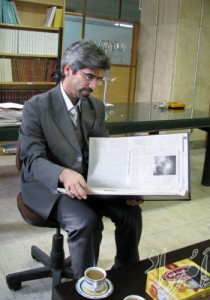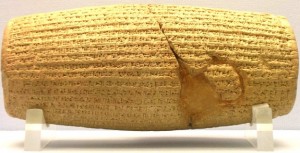Historians and laypersons are greatly indebted to Dr Dariush Akbarzadeh for defending the legacy of ancient Iran and Cyrus the Great against the historical revisionists such as Dr. Parviz Rajabi.
Dr. Parviz Rajabi has insulted the Zoroastrian community, defends Spiegel Magazine’s attacks against Cyrus the Great, criticizes Iranians for defending their heritage against the movie 300, claims that no dangers exist against ancient Iranian sites such as Pasargardae, and attacks those Iranian historians in the west who seek to defend ancient Iran’s heritage. He also claims that only Europeans are qualified to write about ancient Iranian history as it was they who started to translate the old Persian, Avestan, and Middle Persian texts. Dr. Rajabi also denigrates the legacy of the Sassanians. Dr. Rajabi’s comments are often conveyed in the Etemad newspaper.
Dr Dariush Akbarzadeh is the Head of the academic group of ‘Ancient Linguistics and Cultures’ in Azad University of Abhar, a member of the scientific board of the Cultural Heritage Organization and senior expert of the National Iranian Museum, the Chief Editor of the research periodical “The Archeologist’s Message”, an expert of the international program “Yadman” (memorial) in the international channel of Iran TV, the author of books in ancient linguistics: “Kartir Inscriptions”, Mobedan Mobed”, “Pahlavi Scripts”, “Central Asia’s Persian Scripts”, “Parthian Pahlavi Scripts” and many other works.
Dr Dariush Akbarzadeh is a graduate in Ancient Cultures and Linguistics from Tehran Azad University. In his student years and later, in his professional work as a scholar, he has had close cooperation with the famous professor in Ancient Iranian Linguistics, Dr Katayun Mazdapoor.
Dr Akbarzadeh received Farid Shoulizadeh in the experts’ office of the National Iranian Museum. In part of this interview, we had a discussion about the events of the past three months and interview of ‘Etemad’ newspaper with Parviz Rajabi (November 09 and January 10). Below is the interview originally posted in the Amordad News Agency of the Zoroastrian Community.
Dr. Dariush Akbarzadeh in his study. He is among a growing number of researchers in iranian Studies who are concerned with the growing tide of histoprical revisionism.
==================================================================
Q: In the past few months we have noted denial of clear historic evidences in Etemad newspaper. Historic facts about the life and heritage of Kourosh the Great, particularly the text of the Human Rights charter of this just king, has been questioned by certain people who have themselves commended these historic documents in their writings. How do you interpret the denial of the historic evidences?
A: I can only consider these words of our friends as unfair and strange. There is one important point that is not given proper attention in cultural meetings. Our country lacks experts in Assyriaology. This absence has been one of the most fatal blows that we have suffered from in the past 70 years of the academic life of our country. Under the sub-group of experts in Assyriaology, we have expertise in fields like ‘Ancient Babylonian Scripts’, ‘Middle Age Babylonia’ and ‘Neo-Babylonia’, also knowledge of Elamite scripts, Sumer scripts, especially Sumerian language, and . . . all under this group! Though Iran posseses a large collection of ancient scripts and archeological effects in the field of Assyriaology in the National Iranian Museum, also in Khuzestan province and Fars Province, and . ., but we do not have even one specialist in this field. Automatically, comments of those who have graduated in Assyriaology will lose its color.
The Cyrus Cylinder
(The British Museum)
But, specifically, the Human Rights Commandments of Kourosh the Great was selected by the UN, in the 70s, as the first symbol of peace, equality and co-existence in the history of mankind. A duplication was made and is kept in the UN. We should know that it was not without reason that the world society came to this result, and therefore, denial of the historic truth of this charter is an insult to the reasoning and wisdom power of mankind. If we refer to the text of this clay cylinder we will face undeniable facts. In the charter it is clearly stated that the people are free to perform their religious rites. Kourosh clearly states that he has let the people go back to their homelands and place their idols, which had been captured, back in their original places, and rebuilt the temples that had been destroyed. This is despite the fact that Kourosh did not believe in those idols and temples and had a different religion from those people. What
else can we name the commandments of Kourosh the Great, which is full of magnanimity, liberal mindedness, equality and respect to all people and beliefs, if not ‘Human Rights’?
Q: When an across-country newspaper, like Etemad, transmits such baseless and alleged information and gives wrong information to the common reader who has no knowledge of details of historic researches, what should be done?
A: Nowhere in the world do we see such differences, tensity and disquiet in professional and scientific debates that you have seen in the past few months. But, in a country like Iran it is normal! When in Iran we do not have a specialist in the field of Assyriaology non-experts allow themselves to comment on matters that are beyond their knowledge and expertise. One of our big problems is that we do not do professional research. Everywhere in the world experts in linguistics, for example, Neo-Babylonia or Ancient Babylonia or Pahlavi, etc., work professionally and with expertise and do not go out of their field. It is not so in Iran. As you have been witnessing yourself, people allow themselves to comment in a vast area.
Q: We know that a long term solution for this problem is no doubt training of specialized manpower and this refers to our universities which have to train professional scholars. But, what is the short term solution?
A: A short term solution can be you (Amordad biweekly) and other cultural centers and lovers of Iran. You, as a specialized newspaper in the field of Iranology, can transmit transparent information among the people. Your transmission of accurate, transparent and continuous information can, to a large extent, prevent such ill intentions in a short term. We, in the National Iranian Museum, hold lectures every Tuesday afternoon, in the field of Iranian history and culture.
Q: Since your board of specialty is in the field of ancient Iranian linguistics and culture and you teach this field in the universities of Iran, how do you evaluate the statements of Mr Parviz Rajabi about Gathas and his questioning genuineness of this divine book? Should we doubt the genuineness of Gathas of Zarathushtra?
A: This subject is absolutely clear and obvious, even for those who have little knowledge of Avesta. I should clearly state that I take this as a joke that someone denies one of the most ancient and honorable heritages of mankind.
In Gathats Zarathushtra calls himself, several times, as first person and third person. The same way as Darius the Great talks as first person in his inscription and names his ancestors. Now, imagine that someone tries to deny such a clear document and says that this inscription does not belong to Darius and there has never been such a person!! I, as a person who deals with the Avesta language daily, announce that Gathas is the oldest part of Avesta and there is not the least doubt that it was written by Zarathushtra. The name of Zarathushtra is repeatedly mentioned in Gathas and naturally no one else by the name of Zarathushtra or at a later era someone else could have written it. If Gathas or part of it would have been written in the name of Zarathushtra or at a later era someone else wrote it, he would have undoubtedly had difficulty with its language. The manifestation and ancientness of this language is a proof to dismiss this groundless
allegation.
Q: Is it possible that in the recent centuries someone could have composed such hymns or added verses to them?
A: This is impossible in the field of ancient linguistics. It was impossible even thousands of years back, in the period of Avesta I will give an example so that you understand this matter easily. In the museum and cultural heritage sector, we come across duplicates which have been forged or copied skillfully. But, since in this field and knowledge these days we have access to advanced technology, distinguishing them is very easy. Especially in the field of Avestology this is impossible. The structure of the language of Gathas and Avesta is amazingly original and pure. Giving out such statements by persons who have some knowledge in research in Iranology will only make their academic and scientific credit questionable.






